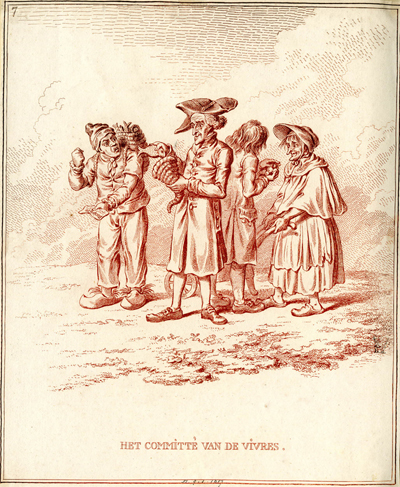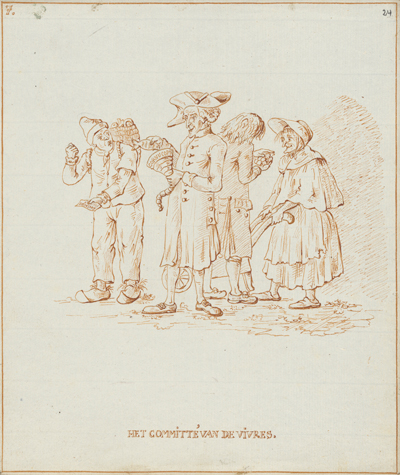Het Committé van de Vivres
This is the seventh plate of a twenty plate series, Hollandia Regenerata, etched by Gillray based on drawings by the Swiss soldier, painter, and caricaturist, David Hess. For more about David Hess, and the political and artistic context of the series satirizing the newly-created and French-supported Batavian Republic, see my Introduction.
The title can be translated as "The Rations Committee." The actual committee that Hess based his satire upon was called the Comité van Vivres en Noodwendigheden (The Committee of Rations and Necessities). According to the "Explanation" accompanying the print, two members of the committee are purchasing dried fish and turnips "for the country." One of them holds a cornucopia whose meagre size suggests that it is a horn of scarcity not plenty. The angry reaction of the fish seller makes it clear that the payment he receives is similarly inadequate. But it is also clear from the "Explanation" that this is all the food and payment these "novice republicans" are going to get.

Het
Committé van de Vivres
[1796?]
© Trustees of the British Museum
As Simon Schama well documents in his book Patriots and Liberators, the Dutch Patriots endured a rude awakening from the French Directorate after the proclamation of the Batavian Republic. Expressions of equality, solidarity, and fraternity before the announcement soon became demands by an uncompromising military victor afterwards. Indeed the French refused to recognize the fledgling republic as the legitimate government of the Netherlands until their demands were met.
It is in this context that we must see the Biblical quotation Hess chose as annotation to the print: Prov. xiv. 23. "In all labour there is profit: but the talk of the lips tendeth only to penury." It is in effect a bitter complaint about the discrepancy between French protestations of fraternity and generosity and their later ruthless behavior.
One of the demands from the French was for a substantial indemnity amounting to 100 million livres to cover French expenses supposedly incurred during the war. Another was for ongoing support for an occupying army of 25,000 French troops. Sometimes this seems to have been paid in currency, but more often than not in the goods required by the army, including provisions for their horses, clothes, shoes, food, and drink.
According to Ralph Fell in A Tour Through the Batavian Republic published in 1801,
To relieve the presssing necessities of the French army, a requisition was made by the representatives of the French people for a supply of clothing and provisions to be delivered in the space of one month. . . [This included] 200,000 quintals of wheat. . .5 millions of rations of hay, 200,000 rations of straw, 150,000 pair of shoes, 20,000 pair of boots, 20,000 coats and waistcoats, 40,000 pair of breeches, 150,000 pair of panataloons, 200,000 shirts, 50,000 hats, and 12,000 oxens.
Requisitions owed to the French army were given priority over feeding their own people, so the Dutch basically beggared themselves to meet the demands of their revolutionary brothers. And to make matters worse, the payment the Dutch received for these provisions was rendered in increasingly worthless recipissen. This led inevitably, as Simon Schama says, to a downward spiral of "of hunger and debt."
It is in this context that we must see the rest Hess's commentary. Here is the French text of the "Explanation."
Les membres de ce Committé viennent de faire une emplette pour alimenter le pays. Une poignée de raves et un poisson sec suffisent à des apprentifs-republicains. On voit bien que ce pecheur, qui a vendu le poisson, ne sent pas encore tout le prix de la liberté, puisqu'il grogne de n'avoir reçu qu'un Recipisse en place d'argent comptant.
And here is my free English translation.
The members of the Committee have just made a purchase to feed the country. A handful of turnips and a dried fish are sufficient for these apprentice republicans. One sees well that the sinner who sold the fish is not yet aware of the price of liberty since he grumbles about having only received a receipt in place of actual cash.

Het
Committé van de Vivres
[1796?]
© Zentralbibliothek Zürich
As in most of the plates of Hollandia Regenerata, Gillray follows the Hess's drawing very closely. The disposition of the figures and the details and meaning of the print all derive from Hess, but Gillray has sharpened every line and, with a wonderful use of shading, given a depth and solidity to the background, foreground, and figures (especially their clothes) that is missing in the original Hess drawing.
Sources and Reading
- Commentary from the British Museum on Het Committé van de Vivres.
- Draper Hill, Mr. Gillray The Caricaturist, 1965, p. 73 & note.
- "Batavian Republic," Wikipedia
- "David Hess (painter)," Wikipedia
- "David Hess," SIKART Dictionary
- David Hess, Hollandia Regenerata (1797), Nawoord by Joost Rosendahl, Uitgeverij Vantilt, 2007
- Treaty of The Hague (1795) Wikipedia
- Simon Schama, Patriots and Liberators: Revolution in the Netherlands 1780 - 1813, London, 1992
- Ralph Fell, A Tour Through the Batavian Republic
Comments & Corrections
NOTE: Comments and/or corrections are always appreciated. To make that easier, I have included a form below that you can use. I promise never to share any of the info provided without your express permission.